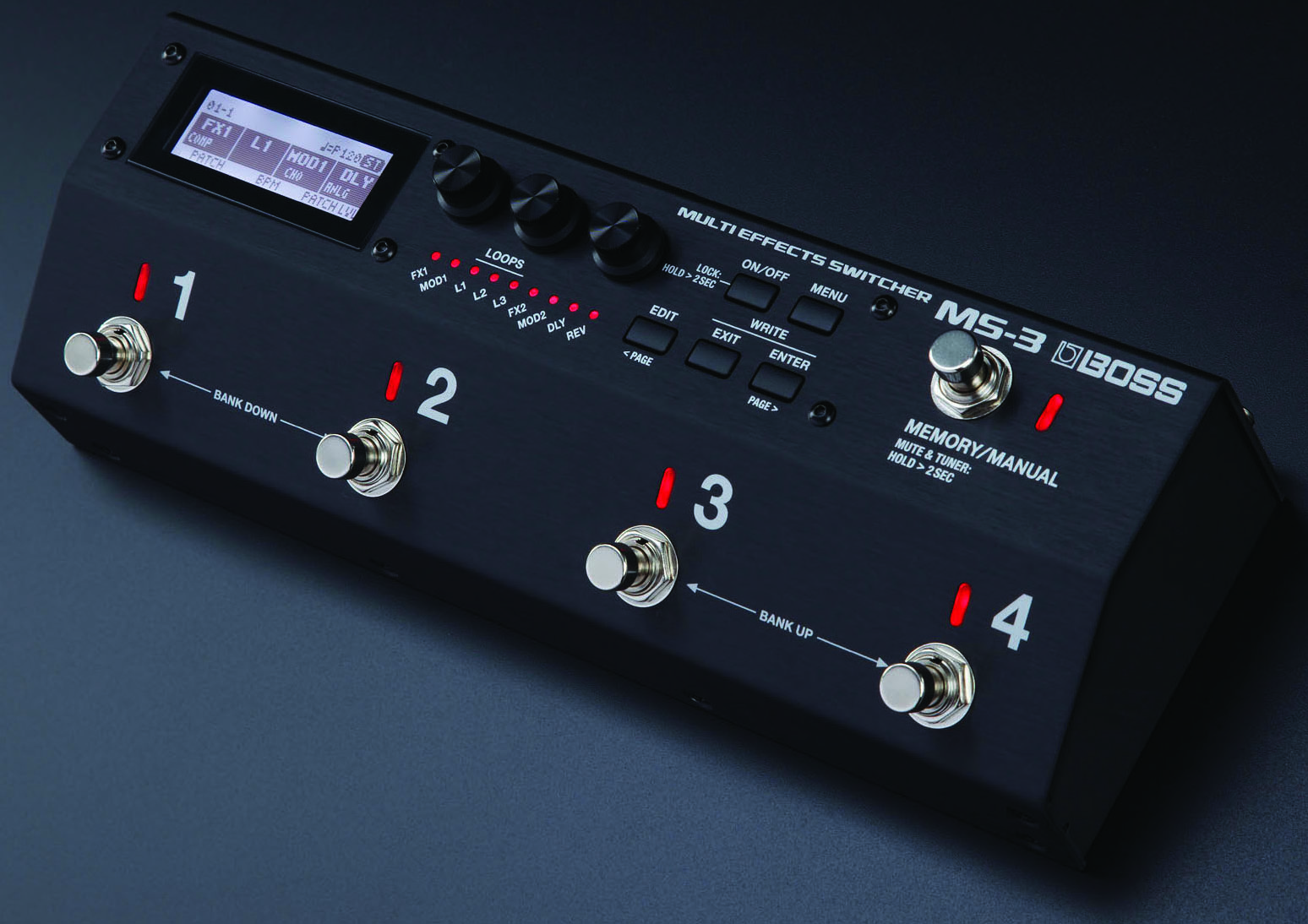Review: Boss MS-3 Multieffects Switcher

When it comes to effects, most guitarists fall into one of two camps: those who prefer the creative flexibility of using various stomp boxes and those who prefer the power and all-in-one simplicity of a multi-effects floor unit. Players who want to use pedals and multi-effects in the same rig often find that integrating the two is not as easy as it should be, with the compromises outweighing the benefits.
The Boss MS-3 solves that dilemma by combining a powerful loop switcher with a versatile multi-effects unit in a compact controller that makes it easy to configure a portable system where pedals and multi-effects co-exist perfectly. The MS-3 is as powerful and versatile as many competing loop switching systems that cost considerably more and don’t have the added benefit of built-in effects. It can even control external MIDI equipment and perform amp channel-switching functions.
FEATURES
The Boss MS-3 budget multi-effects pedal is only about the size of four compact pedals placed side-by-side. It’s housed in a sturdy, pro-quality steel chassis and provides four clickless angled footswitches for selecting banks, patches and assignable functions, an additional clickless footswitch for selecting memory or manual mode and mute or tuner functions. Three control knobs are provided for editing parameters, and five control buttons and a large, brightly illuminated black and white display make it easy to edit patches.

The MS-3’s rear panel features 12 ¼-inch jacks arranged in a straight line to keep cables tidy. There’s a mono input jack, send and return jacks for three loops, right and left/mono output jacks, control output (for functions like external amp channel switching, reverb on/off or tap tempo) and two control inputs for expression pedals or controller switches. A USB port allows users to connect the MS-3 to a computer for editing and saving patches, and a MIDI output enables the MS-3 to control external MIDI devices.
The MS-3’s internal multieffects section provides 112 24-bit effects, up to six of which (one per effects category) can be used simultaneously in a patch. Typical of a Boss multieffects unit, pretty much every effect you can imagine is available, including overdrive, distortion, EQ, compression, wah, octave, pitch shifting, chorus, phaser, flanger, tremolo, rotary, delay, reverb and even special effects like acoustic and sitar simulation, slow gear, feedbacker and ring modulation. Even effects for bass are provided. The three effects loops allow users to place their pedals in any position in the signal chain and save that configuration in any of the 200 available patch memory locations.
PERFORMANCE
Setting up the MS-3 is uncomplicated and straightforward, thanks to the large LCD that makes it easy to navigate the various pages and functions. There is a bit of an initial learning curve for those not used to programming Boss multieffects units, but it should take most users less than an hour to get the hang of it.
Similarly, the MS-3 is very easy to use for live performance. For me, it made the most sense to program banks by song to provide instant access to four different patches (such as rhythm1, rhythm 2, solo and outro) without having to switch banks. The biggest advantage over using basic loop controllers is that the MS-3 can switch between two entirely different groups of effects and even entirely different signal path routings with the press of a single footswitch. I also loved how my pedals were able to integrate seamlessly in patches while allowing me to retain their indispensable and unique character.
Get The Pick Newsletter
All the latest guitar news, interviews, lessons, reviews, deals and more, direct to your inbox!
I especially enjoyed being able to put together an incredibly versatile effects rig with my own individual sonic signature that takes up maybe a third of the space of a pedal-only rig that provides only half or less of the MS-3/pedal rig’s sonic capabilities. The MS-3 is more than versatile enough on its own, particularly since it provides a full assortment of pro-quality Boss effects. While it’s small enough to fit in a gig bag pocket, and many guitarists will probably use it that way, the MS-3 also is capable of controlling a much bigger rig, so it can remain a central part of your effects system as your needs grow and become more sophisticated.
STREET PRICE: $399.99
MANUFACTURER: Boss, boss.info
- Three loops allow users to seamlessly integrate pedals with the MS-3’s multieffects and place each loop in any desired location in the signal chain.
- The large, brightly illuminated black and white LCD makes it easy to program patches and edit the unit’s built-in effects.
- A total of 112 24-bit effects are provided, and up to six effects (one from each group) can be used simultaneously.
- MIDI and control output jacks allow the MS-3 to control external MIDI devices and perform functions such as amp channel switching.
THE BOTTOM LINE
Multieffects and pedals now can get along perfectly, thanks to the Boss MS-3, which can function on its own as a multieffects unit and also control a large rig with several pedals, amps and MIDI devices.
Chris is the co-author of Eruption - Conversations with Eddie Van Halen. He is a 40-year music industry veteran who started at Boardwalk Entertainment (Joan Jett, Night Ranger) and Roland US before becoming a guitar journalist in 1991. He has interviewed more than 600 artists, written more than 1,400 product reviews and contributed to Jeff Beck’s Beck 01: Hot Rods and Rock & Roll and Eric Clapton’s Six String Stories.
“The original Jordan Boss Tone was probably used by four out of five garage bands in the late ’60s”: Unpacking the gnarly magic of the Jordan Boss Tone – an actual guitar plug-in that delivers Dan Auerbach-approved fuzz
“This is a powerhouse of a stompbox that manages to keep things simple while offering endless inspiration”: Strymon EC-1 Single Head dTape Echo pedal review












